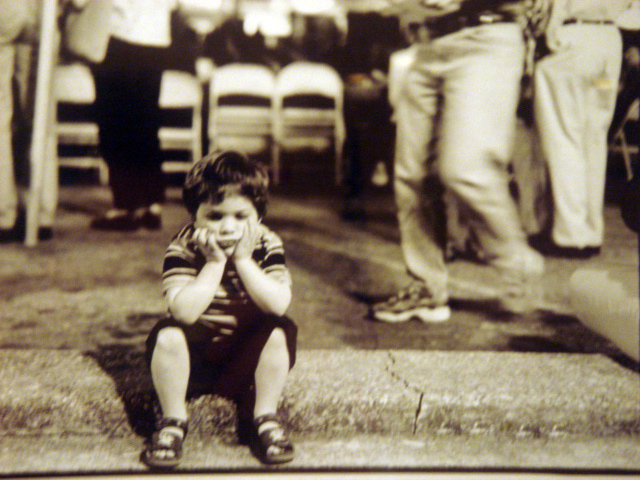LOC09:06
06:06 GMT
 The artist's young cousin, Christopher, takes a quick break from dancing at Lebanese cultural festival
The artist's young cousin, Christopher, takes a quick break from dancing at Lebanese cultural festival
Feature by Heather Yamour (with photos) WASHINGTON, April 26 (KUNA) -- A Lebanese-American artist offers a unique insider's look into the everyday lives of Arab families living in America, in a new four-week long photo exhibition aimed at telling the American public that Arabs in the US, or abroad, are like everyone else, "good people." Artist Amy Joseph began taking photos of her family in 2005. It took several trips, and a lot of gas mileage, across the Southeastern United States to photograph her parents, aunts, and cousins to capture the essence of what it means to be an Arab living America.
In the years following the terrorist attacks in New York City and Washington DC on September 11, 2001, Arabs in the US and abroad have faced negative stereotypes in the media and by the general American public, for many of them, the common stereotypes, as terrorists or oppressors of women, have had difficulty breaking these misperceptions in order to find common ground.
Her artwork, "From Brummana to Birmingham: A Lebanese American Family," on display at the American-Arab Antidiscrimination Committee's (ADC) headquarters in Washington DC, displays 27 black and white documentary photographs of every-day life of Arab Americans, paired with five text panels.
The exhibit tells the story of her fathers parent's voyage from the Lebanese mountain town of Brummana to upstate New York in the 1920s, as part of a wave of immigration to the US known as the Great Migration.
The result is an intimate look at Arab American lives, taking viewers inside the homes, kitchens, and birthday parties that showcase strong family ties, commonly found throughout the Middle East, highlighted with laughter, dancing, and food.
Her paternal grandparents, Maronite Christians, raised Amy's father and uncles to take pride in their Lebanese roots, and cultural values which has been passed down to Amy and her cousins.
Amy, who is Lebanese and Italian on her mother's side, said she started with her family because they represent the core of her cultural identity.
"This is what I know about being Lebanese, all these amazing people," said Joseph, standing next to a photo of her aunt flipping through a cookbook in the kitchen, while behind her shoulder one of her young cousin's sits at the kitchen table.
But while growing up, Joseph said she noticed disturbing news headlines and articles that shined a negative light on Arabs in the Middle East, that have raised negative stereotypes in the US.
"Looking in the newspapers and reading all these horrible things I feel like they're not true about the Middle East, especially now, I see Arab is associated with terrorist and all these awful words. I feel like the reality of it is not seen." She calls this exhibit a "base of a broader project about people throughout the Middle East and North Africa." In one panel she tells viewers, "Through documenting everyday life, it offers the opportunity to see into people's lives and see people as who they are and not who the stereotypes decide they are." At the public opening of her art exhibit, Joseph, proudly pointed out one of her favorite photographs on display.
It shows her three-year old cousin, Christopher, at the annual Lebanese Cultural festival in Birmingham, Alabama, Joseph explained, pointing out the rows of chairs people standing in the background, and "for a second he sat down and then he got back up and started dancing again," she said with a laugh.
"Arab Americans are good people, living their lives, raising their families. I'm hoping by showing who we are as people and that we have a lot of similarities with the broader American community, that it would help break some negative stereotypes." "I think we can learn a lot about each other and each other's stories, and we can use that to build bridges," said Joseph.
In her next project, Joseph, is teaming with a writer who is also Lebanese American, to expanding her work to cover common ground and diversity among the Arab American community.
"It's very diverse and the different ways being Arab plays a role in our lives. To show we are diverse and play so many roles from little things to how you decorate your house to larger roles presidential candidates and marriage," said Joseph.
According to Laila Al-Qatami, communication's director for the ADC, Joseph's work resonates with people because it shows Arab-Americans doing things that everybody else does, and like a rising number of other Arab-American artists, her work challenges the negative, uni-dimensional portrayals of Arabs, often times perceived by the general public.
"We're trying to show people that Arabs aren't that different from everybody else," said Al-Qatami.
According to Al-Qatami, the artistic talent pool is growing but many artists face the challenges finding venues, or clearing houses to showcase their work. For many, funding also poses a real issue.
There is a growing number of Arab Americans involved in film, music, and general arts, notes Al-Qatami, many of whom are in the late 20s or 30s.
"I think we are going to start seeing more of an impact in the coming years, " said Al-Qatami.
The "Brummana to Birmingham" art exhibit runs from April 22, 2008 until mid-May and is available for free public viewing based on appointment only. (end) hy.ema KUNA 260906 Apr 08NNNN